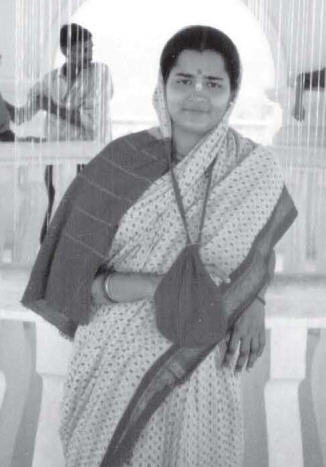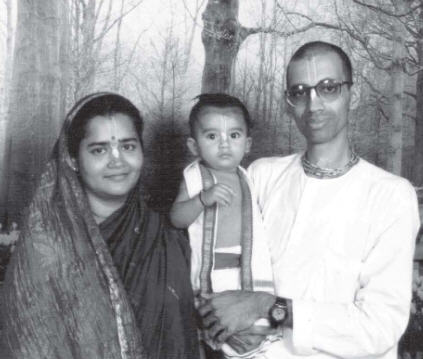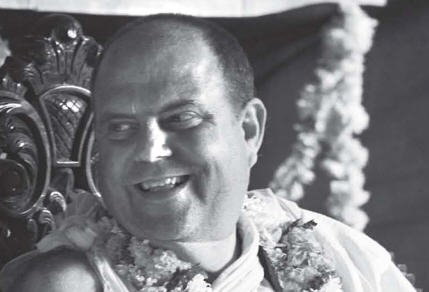Destiny would have turned her into a nonbeliever, but Krishna’s mercy pulled her out of the pitfall of impersonal atheism.
I wrote that I hate Jinnah,” said Ruth. Jyoti added, “I wrote that I hate Nehru!” Chitra, my best friend, was more positive: “I wrote that I am grateful to Gandhi.” It was 1984. We were in class 10, discussing our responses for the essay “A Recent Film You Saw.” We had all written on the film Gandhi.
I had been greatly impressed by the film and inspired by Gandhi. But the strong statements my friends made goaded me to delve deeper into the freedom movement and decide whom to hate and whom to appreciate. After reading several books, I was no wiser in deciding whom I should hate. However, following Gandhi, I made changes to my lifestyle—I began to sleep on the floor, I fasted on Ekadashi, and I reached out to the poor and hungry.
INTRODUCED TO THE BHAGAVAD-GITA

Gandhiji called the Bhagavad-gita his “guiding force.” During my spirited teens I decided that I too must read the Bhagavad-gita and become as great as Gandhi! I found the Bhagavad-gita as absorbing as a novel. In my eagerness to know Krishna I skipped through the commentary. As I read, my teenage mind fell in love with Krishna. He became my absolute “boyfriend.”
Up until now, I had been a bundle of inferiority complexes. I was skinny and unimpressive, a failure at academics and a dull friend. Though I was learning music and dance, comments of friends attempting humor ate at my confidence in the arts as well. I was not happy at home, though there was nothing particularly wrong there, and I yearned for love. My attempts to find that love in romance novels brought some relief but not enough. Now, introduced to Krishna, a natural attraction for Him arose, and with it, love.
I was not new to the path of bhakti. My parents were very pious. My mother would strictly perform her Shiva-japa every morning and celebrate all festivals grandly. My home resounded with classical songs and dance in praise of the Divine.
My maternal grandmother was also an extremely pious lady. With her eight children and her husband, she walked the 2000 miles from Burma to India during World War II. By the time they arrived, three of her children and my grandfather had died. A year after my grandfather’s death, my grandmother, about thirty years old at the time, donned saffron robes, shaved her head, and engaged herself completely in spiritual activities.
FOLLOWING THE BHAGAVAD-GITA
Reading Bhagavad-gita revived the devotion she and my family had instilled in me during my childhood. Two particular instructions from the Bhagavad-gita became part of my life.
One was to “do your duty without worrying about the result.” This drew me out of my self-conscious shell. Giving up fears and complexes, basking in the confidence of Krishna’s love, I participated in all the competitions and events at school. Why? Because He said not to worry about the results! These two years of class 11 and 12 were wonderful for that reason. I was always blissful, enthusiastic, and I even became a good performer both in academics and the arts.
The other instruction was the yoga process taught in chapter six. Whenever I attended any spiritual program I would sit with a straight back and concentrate on the tip of my nose with half-closed eyes.
Once I found my classmate Rita in a sad mood. “I can understand that you are suffering from an inferiority complex,” I said. “Why don’t you take shelter of your Lord Jesus? I took shelter of my Lord Krishna and now I am so happy.” Rita became a serious Christian. Several years later, she did me a good turn by bringing me back to devotion from the brief period of atheism into which I had ventured.
INCREASING ATTACHMENT TO KRISHNA

Once, when one of my aunts visited our house, she brought a small part of the Mahabharata to read. This portion spoke of Lord Krishna’s friendship with the Pandavas. Seeing Krishna’s friendship with His devotees, my attachment to Krishna grew even more. From treating Him as a “boyfriend,” I began to revere and pray to Him.
My extremely religious geography teacher gave me a big calendar with a picture of Krishna playing His flute. This Krishna became my all-in-all. I would talk to this picture and base my decisions on how the calendar moved: left meant “yes” and right meant “no.” I now had a very close friend.
Once, when I was riding my bicycle to my aunt’s house in the dark, I became afraid. I prayed to Krishna. When I reached my destination and parked my bicycle, a leaf that had fallen off a tree on the road reminded me of the leaf Krishna lies on at the time of universal dissolution. This assured me that Lord Krishna had been with me during the ride.
I used to have a terrible fear of ghosts. Once, when I was in the car park of our flats with my sister, it became dark and my own sister looked like a ghost! In fear I prayed to Krishna. Then, as I watched, my sister passed behind a concrete pillar, but who came out on the other side was, to my vision, a form of Krishna as I had seen in dances and dramas! I learned to see my friend Krishna in others rather than a “ghost.” This helped me overcome my fear to a large extent.
These two extraordinary incidents and others like it helped me maintain faith in Krishna, even when I was led into atheism by a group of Mayavadis.
Though the final two years of school were spent in devotion to Krishna, the beginning of college saw me enter a phase of meditation and questioning. Any silly thing could send me spiraling into philosophy. But I was stumped when I arrived at this question: Who is more powerful—God, fate, or prayer?
INTRODUCTION TO MAYAVADA
I took this particular question to my cousin-brother, who is a serious Mayavadi. With his encouragement I started attending Mayavada classes and began to deny the existence of Lord Sri Krishna! I came to think that devotion was a crutch for people like Rita, a way to find an anchor in life. And the universe was simply too wonderful and systematic. How could one person possibly engineer and then take care of the whole thing?
I slipped into what I called healthy atheism. Mayavada encourages atheism: for them, neither the Lord exists nor the world. Nothing exists but Brahman. And if I asked something based on sastra, I was told, “Even sastra is false!” What can you speak or think when everything is false? At least contrasted with regular atheism, Mayavada philosophy fosters good qualities and habits and ensures good citizenry.
Although talking like an atheist, how could I forget Krishna? How could I become ungrateful to Him for being my friend and for all the times He had helped me? Internally I would tell Him, “Dear Krishna, please forgive me for saying You do not exist. But I need to know You scientifically, not just sentimentally— on the basis of the special exchanges we have had.”
THE TURNING POINT
Being Literature students, we were expected to read a lot. Once, I got a very interesting book by Arthur Conan Doyle, and that was the turning point in my “atheistic” life. Doyle, along with leading citizens of the Victorian age, conducted several experiments to study whether ghosts really existed. At that time, the only theory of origin available for atheists was Darwin. The Big Bang theory was not yet in vogue. But Darwin’s theory had many flaws. One major flaw I had just discovered was that he did not even mention about ghosts but here was a book serializing experiments that tried to prove their existence.
After reading several more books and meditating on Darwin’s theory, I came again to a crucial question: Let’s say God does not exist. But I know that I exist! What, then, is the source of my existence?”
BACK TO DEVOTION
At this point I was in my final year of college. I was given the assignment to find a topic outside of college and make a presentation on it. I was completely at a loss for a topic. My good friend Leela Pal Choudhury then invited me, “I am going to ISKCON to conduct my interviews. Come with me and ask questions. As you are an atheist, it will be more interesting.”
So one sunny afternoon, Leela and I dropped in at the ISKCON temple in T. Nagar, Chennai. We were taken to the room of the then temple president Ganga Dasa, an Italian by birth.
Ganga Prabhu was patient as we poured forth our questions. I liked his analogy of a fish out of water to explain the condition of the jiva lost to spiritual life. I soaked up his words like a sponge. Unfortunately for Leela, I had no atheistic front to put up any more as all the answers that he gave sounded logical.
I asked him why he had left Christianity to embrace Hindu culture. He said, “There is no question of leaving anything. It’s just like going from the lower classes to the higher classes in school. I was interested in joining the clergy in Rome, but I was disappointed to see the priests smoking and drinking. Their lifestyle did not appeal to me.” Then he discovered Krishna consciousness.
The necessity to conduct interviews gave me the opportunity to speak to almost all the devotees in the temple and find out what had attracted them to ISKCON. Nimai Nitai Dasa, the head pujari of ISKCON Chennai, explained how he would visit ISKCON often simply because he liked the smell of the incense.
Soon I met Lila Padma Devi Dasi, the wife of the then vice-president, Radhika Ramana Dasa. On her invitation, every Sunday I dropped in for three hours before the program and spent the afternoon with her, asking my never-ending questions. I read Srila Prabhupada’s books, hoping to find a question he couldn’t answer. But I realized that every question I had was convincingly answered by Srila Prabhupada.
CHANTING AND THE GREAT RELIEF
I started chanting. The greatest benefit I derived from chanting was relief from daydreaming. I was a heavy daydreamer. If I was dreaming that I was India’s President, I would continue the dream until I was cremated in harness. My daydreams made me miserable. But now I would sing Hare Krishna as I went through the mechanical household chores. Peace and happiness filled me.
SLOW GROWTH
Though I liked the philosophy of Krishna consciousness, along with the kirtana and prasada, I was not ready to chant more than four rounds a day. Even those four rounds were done with absolutely no attention, as my ears would be drawn to the dialogues running on the TV in the other room.
I tried reading the Bhagavad-gita As It Is, but could not get past text 2.39, where Srila Prabhupada explains buddhi-yoga as Krishna consciousness. I just could not figure out how buddhi, which literally means intelligence, could mean Krishna consciousness. Confused, I would be unable to read further. I also made the colossal mistake of comparing different translations of the Bhagavad-gita: editions by Chinmayananda, Chidbhavananda, and Srila Prabhupada. The differences made me tear my hair out!
FINAL DECISION
What made matters worse was the rescreening of Gandhi on TV. My heart again went out to Gandhi, who had placed me on the path of spirituality. Confusion reigned in my heart. “Why ISKCON?” I asked myself. “Why not Sabarmati Ashram? Why not Ramakrishna Mission? Why not Mother Teresa?” As my mind reeled, my mother called me in for dinner. When I was finished, I picked up my plate to wash it and my tongue automatically slipped into a tune of the Hare Krishna mantra!
“That’s it!” I decided. “I am going to become a Hare Krishna devotee because I like it! I love singing; I love kirtana. Singing Hare Krishna has cured me of my miserable daydreaming, and chanting has silenced my mind. What more can I ask for?”
INTRODUCED TO GURU

One day His Holiness Jayapataka Swami visited Chennai. I listened to his arrival lecture. Later, after helping with services related to his dinner, I began to grind the batter for idlis. It was about 2 am when I finally got to sleep.
The next morning I was helping with the breakfast service when I heard the sound of Hare Krishna kirtana. Tears rolled from my eyes. I couldn’t understand what was happening to me. It seemed that Guru Maharaja was giving me a glimpse of the mountain of ecstasy available in the holy name. I had not yet been introduced to Guru Maharaja, so I had not spoken personally with him, but somehow, by his merciful glance, my consciousness had been purified.
A few days later, I began reading Bhagavad-gita As It Is for the third time. This time I easily read past text 2.39. The obstacle of doubt caused by my ignorance and my arrogance had been removed. And then one morning, I woke at 3.30 am feeling so fresh and bright that I immediately started chanting. On that day I began my practice of chanting sixteen rounds everyday!
By the causeless mercy of guru, I was given the ability to read Srila Prabhu-pada’s books and chant the holy name. I could delve deeper into the process of Krishna consciousness instead of staying on a mental and intellectual level caused by my association with Mayavadis. My guru continues to help me in so many ways in my devotional service, and I am indebted to him forever.
So I was “led by the hand” by internal and external guidance to give up dharma (mundane social service), artha (pursuit of economic advancement), kama (lust for the material world), and moksa (the path to liberation as taught by the Mayavadis). I was brought into the association of devotees, who showed me the path of pure devotion to Lord Krishna. The Srimad-Bhagavatam (3.33.7) says that a person who is practicing devotional service has already performed all ritualistic acts such as giving charity, visiting pilgrimage sites, and so on. I feel that in my early life I was taken on a tour of these things to confirm to me their inferiority in comparison to devotion to Lord Sri Krishna just so I could be more determined in my practice in this lifetime and come closer to achieving the real goal of life.
Tarini Radha Devi Dasi is the mother of four children, and she coordinates children’s programs in Chennai, Tamil Nadu. Contact her at tariniradha@pamho.net.
